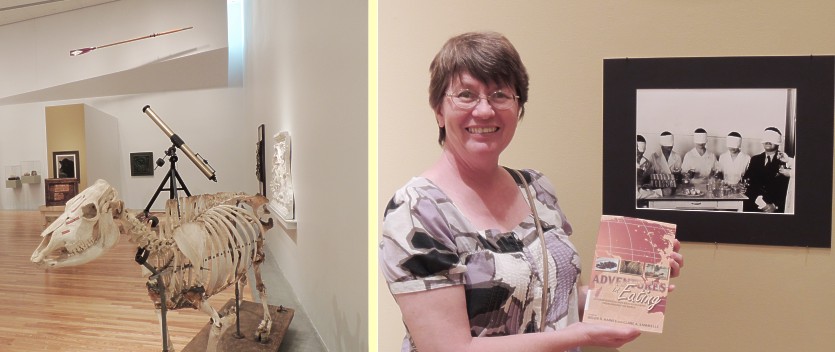Kansas Snapshots by Gloria Freeland - August 2, 2013
A sense of wonder
Part of Kansas State University's 2013 sesquicentennial celebration is the Museum of Wonder, billed as "an
eclectic mix of objects representing K-State's past, present and future." Every summer when sister Gaila comes to
Kansas, we select one day as "Sister Day" - a day when just the two of us go off by ourselves. We decided
the "Museum of Wonder," an exhibit of the university's Beach Museum of Art, would be part of our Sister Day agenda.
Among objects were a cow skeleton, fossils, costumes, taxidermied New Hampshire Red chickens, boxes of mounted
insects, books, wheat samples, household items, telescopes, microscopes, carvings, maps, models, paintings and tools.
As we worked our way around the room and the adjacent "Library of Wonder," Gaila and I stopped to examine some
of the items more closely.
She picked up a book, "Adventures in Eating." On the wall above it was a black and white photo of several
blindfolded people ready to do some sort of taste test. Several brightly-illustrated books about birds and insects
also caught our attention as did a jar containing a preserved fish - at least I think it was a fish.
Some of the objects were labeled, but many were not.
There didn't seem to be any rhyme or reason to the way the objects were presented. One set of items on a table
included a K-State centennial medallion from 1963; a piece of pallasite - a stony-iron meteorite - found in Kiowa
County in 1882; a fancy business card holder with a young woman's card tucked inside; a wooden carving of an ear
of corn; a bronze rendering of an ear of corn; and five heads of Turkey Wheat in a shadow box.
Before long, I found myself wondering more about who would have thought to display such a seemingly random
group of items in a single presentation. According to promotions for the Museum of Wonder, the changing exhibits
draw inspiration from 16th- and 17th-century European "Wunderkammern," or "cabinets of wonder," where objects from
many different categories were displayed together.
They were also called "cabinets of curiosities," and being the curious type myself, I had to find out more about
these cabinets. Researching on the Internet - itself a sort of cabinet of curiosities - I discovered that such
"cabinets" lacked the separation and classification of artifacts based on specific fields of study, such as art,
science or history, that are typical of modern-day museums. They were the personal and sometimes quirky collections
of individual, usually-wealthy owners and contained natural and man-made objects.
One example was Sir Walter Cope's collection from the late 1500s and early 1600s. It included "... holy relics
from a Spanish ship; earthen pitchers and porcelain from China; a Madonna made of feathers, a chain made of monkey
teeth, stone shears, a back-scratcher, and a canoe with paddles, all from 'India'; a Javanese costume, Arabian coats;
the horn and tail of a rhinoceros, the horn of a bull seal, a round horn that had grown on an Englishwoman's
forehead, a unicorn's tail; the baubles and bells of Henry VIII's fool, the Turkish emperor's golden seal ..."
The main function of the cabinets was to provoke a sense of curiosity and wonder in the viewer. But the
juxtaposition of disparate objects also encouraged people to look beyond their own world, to try to make connections
across different fields of human knowledge, and to experiment with arranging and re-arranging the objects in
different ways.
The K-State display reminded me a bit of Mom's third grade classroom from more than 50 years ago. What I remember
most clearly from her room was that she always had a variety of interesting items scattered throughout - birds' nests,
insects mounted in wooden boxes with glass tops, rocks, shells and even a Native American teepee. It did create in me
a sense of wonder.
I suppose even our collection of objects in our North Woods cottage could be considered a mini "cabinet of
curiosities." The collection includes twigs rubbed shiny from the sand and wind of Lake Superior; turkey and ruffed
grouse feathers and porcupine quills from Art's fishing trips; a small acorn; large rocks dug from the mud of nearby
Maple Lake; a small orange plastic shovel from our daughters' sand castle days; an orange plastic fish from the
girls' indoor fishing "expeditions" and so much more.
As scientific or logical thinking became the accepted way of describing the world, the cabinets of wonder were
dismantled, their objects were classified into specific categories and they were absorbed into curated museums. This
was understandable, as we frequently need to have objects grouped for ease of comparison to develop understanding.
But it also creates a problem. When we place an object with another that shares a common thread, we also
separate it from yet others with which it may also have elements in common. Curiosity collections may allow
these lost connections to be rediscovered.
Visiting K-State's Museum of Wonder made me reflect on the university's 150 years of contributing to the larger
world in such seemingly unconnected areas of art, agriculture, engineering, architecture, music, veterinary medicine,
textiles, military science and many other areas. It proved to be a good choice, indeed, for our Sister Day agenda!
